Asia · Attractions · China · Going Out · Regions
Discovering the secrets of the Terracotta Army
In 1974 a poor farmer named Mr. Yang was digging a new well in his field when a head rolled out of the earth landing at his feet, followed by an arm, hand outstretched, as if trying to grasp him. He ran in terror believing his ancestors had returned from the afterlife to punish him. He returned later that day supported by two other farmers and they began to dig.
What they found was the start of one of the most extraordinary archaeological finds in history, eight thousand Terracotta Warriors protecting the vast 2200-year-old tomb of the first emperor Qin Shi Huang. He of the Qing Dynasty who built the Great Wall.
 He is known as the Emperor of Two Miracles: the Great Wall and the Warriors. But he also stopped the civil war, unified the country, created a single currency and a common language, invented chrome-plating technology, built high-speed roads and dug canals to connect the Yellow River to the Lijiang and West Rivers, linking the main cities via a 437km waterway network.
He was 13 years of age when he became emperor and started planning his biggest initiative, his own mausoleum, the biggest in the world, out scaling even the pyramids. But his life was to end in tragedy 37 years later at only 50 years of age while his mausoleum was still under construction.
His principle was based on what seems to be an obsession during the China Dynasties, longevity in this life and a fulfilling afterlife. His coffin was to be floated on a river of mercury 100 metres below the surface, which he believed would protect his body, on top of which he instructed to have a 100 metre high hill built surrounded by the natural course of the Yellow River.
He is known as the Emperor of Two Miracles: the Great Wall and the Warriors. But he also stopped the civil war, unified the country, created a single currency and a common language, invented chrome-plating technology, built high-speed roads and dug canals to connect the Yellow River to the Lijiang and West Rivers, linking the main cities via a 437km waterway network.
He was 13 years of age when he became emperor and started planning his biggest initiative, his own mausoleum, the biggest in the world, out scaling even the pyramids. But his life was to end in tragedy 37 years later at only 50 years of age while his mausoleum was still under construction.
His principle was based on what seems to be an obsession during the China Dynasties, longevity in this life and a fulfilling afterlife. His coffin was to be floated on a river of mercury 100 metres below the surface, which he believed would protect his body, on top of which he instructed to have a 100 metre high hill built surrounded by the natural course of the Yellow River.
 Below ground he set traps using crossbows and spears – real Indiana Jones stuff – to protect against tomb raiders and looters. He then commissioned all the craftsmen in the newly unified country to construct life-size warriors to defend him. All eight thousand of them along with horses, animals, eunuchs and acrobats for entertainment in the afterlife. This guy had more than a healthy preoccupation about his own death.
Below ground he set traps using crossbows and spears – real Indiana Jones stuff – to protect against tomb raiders and looters. He then commissioned all the craftsmen in the newly unified country to construct life-size warriors to defend him. All eight thousand of them along with horses, animals, eunuchs and acrobats for entertainment in the afterlife. This guy had more than a healthy preoccupation about his own death.
 Our terrific guide Pan dodged us through the queues and led us to the first of only three pits that have been excavated to date. A construction larger than an aircraft hangar covered the pit containing hundreds of warriors row after row all facing the same direction, their backs to their ruler’s tomb ready to defend his honour. The pit was divided into rooms separated by thick walls and once covered with beamed roofs.
Our terrific guide Pan dodged us through the queues and led us to the first of only three pits that have been excavated to date. A construction larger than an aircraft hangar covered the pit containing hundreds of warriors row after row all facing the same direction, their backs to their ruler’s tomb ready to defend his honour. The pit was divided into rooms separated by thick walls and once covered with beamed roofs.
 Pan explained that Qin Shi Huang had directed clay to be used from a nearby mountain, moulds were made for the life-sized bodies then arms and heads were made separately and attached. After firing they would last forever, protecting him for eternity. Every warrior they have found so far has a different face and the name of the craftsman engraved on the back of its neck. Legend has it that if the emperor didn’t like the design the craftsman would be identified and executed.
‘So, that’s why they’re called “The Terracotta Army”, Pan?’ I asked.
‘No, not really,’ she said.
Apparently, when excavation began, they found brightly painted warriors, but as soon as they were exposed to the air the colours began to fade, and within 30 minutes they were the colour of terracotta, and the description stuck.
Pan explained that Qin Shi Huang had directed clay to be used from a nearby mountain, moulds were made for the life-sized bodies then arms and heads were made separately and attached. After firing they would last forever, protecting him for eternity. Every warrior they have found so far has a different face and the name of the craftsman engraved on the back of its neck. Legend has it that if the emperor didn’t like the design the craftsman would be identified and executed.
‘So, that’s why they’re called “The Terracotta Army”, Pan?’ I asked.
‘No, not really,’ she said.
Apparently, when excavation began, they found brightly painted warriors, but as soon as they were exposed to the air the colours began to fade, and within 30 minutes they were the colour of terracotta, and the description stuck.
 We visited all three of these remarkable pits containing around two thousand warriors standing to attention in line and in expectation of battle, bizarrely resembling a scene from the science fiction film ‘I, Robot’. The detail and intricacy of carving was extraordinary, even after 2000 years the fingernails, facial wrinkles and strands of hair are easily identifiable, particularly on those of a senior military rank where more attention was paid to the carving.
We visited all three of these remarkable pits containing around two thousand warriors standing to attention in line and in expectation of battle, bizarrely resembling a scene from the science fiction film ‘I, Robot’. The detail and intricacy of carving was extraordinary, even after 2000 years the fingernails, facial wrinkles and strands of hair are easily identifiable, particularly on those of a senior military rank where more attention was paid to the carving.
 ‘There are another six hundred pits yet to be discovered,’ said Pan.
This piece of information seemed impossible, but another six thousand warriors have been detected by underground scanner and will not be excavated until the technology is available to protect their quickly vanishing colour. In other pits there are untold treasures still defended by the emperor’s traps and his river of mercury.
It was an incredible experience and another of our adventure’s highlights China had presented us, both from Emperor Qin Shi Huang . So what of his dreadful demise? It seems his obsession with a long life was the cause of his short existence.
‘There are another six hundred pits yet to be discovered,’ said Pan.
This piece of information seemed impossible, but another six thousand warriors have been detected by underground scanner and will not be excavated until the technology is available to protect their quickly vanishing colour. In other pits there are untold treasures still defended by the emperor’s traps and his river of mercury.
It was an incredible experience and another of our adventure’s highlights China had presented us, both from Emperor Qin Shi Huang . So what of his dreadful demise? It seems his obsession with a long life was the cause of his short existence.
 His scholars and advisers referred him to a written legend suggesting there was an elixir for long life that could only be discovered by monks.
‘Off you go then, boys,’ he may have said, ‘and don’t come back without it.’
Of course, it didn’t exist but the monks, in fear of losing their lives if they returned empty handed, found mercury.
‘This looks like it would make a good elixir for a long life,’ they may have said erroneously and returned to present the emperor with the solution to immortality.
The daily potion of perpetuity inevitably took its toll and while the monks survived, the emperor sadly went mad, executing swathes of the population. He eventually died of poisoning and brain damage and the peasants rebelled looting what they could from his Terracotta Army. A sad end for an emperor now held in the same esteem in China as Chairman Mao.
David Moore is Author of ‘Turning Left Around the World’. Published by Mirador and available from Amazon, it is an entertaining account of David and his wife’s travel adventures – often intriguing, frequently funny and occasionally tragic.
If you would like to be a guest blogger on A Luxury Travel Blog in order to raise your profile, please contact us.
His scholars and advisers referred him to a written legend suggesting there was an elixir for long life that could only be discovered by monks.
‘Off you go then, boys,’ he may have said, ‘and don’t come back without it.’
Of course, it didn’t exist but the monks, in fear of losing their lives if they returned empty handed, found mercury.
‘This looks like it would make a good elixir for a long life,’ they may have said erroneously and returned to present the emperor with the solution to immortality.
The daily potion of perpetuity inevitably took its toll and while the monks survived, the emperor sadly went mad, executing swathes of the population. He eventually died of poisoning and brain damage and the peasants rebelled looting what they could from his Terracotta Army. A sad end for an emperor now held in the same esteem in China as Chairman Mao.
David Moore is Author of ‘Turning Left Around the World’. Published by Mirador and available from Amazon, it is an entertaining account of David and his wife’s travel adventures – often intriguing, frequently funny and occasionally tragic.
If you would like to be a guest blogger on A Luxury Travel Blog in order to raise your profile, please contact us.
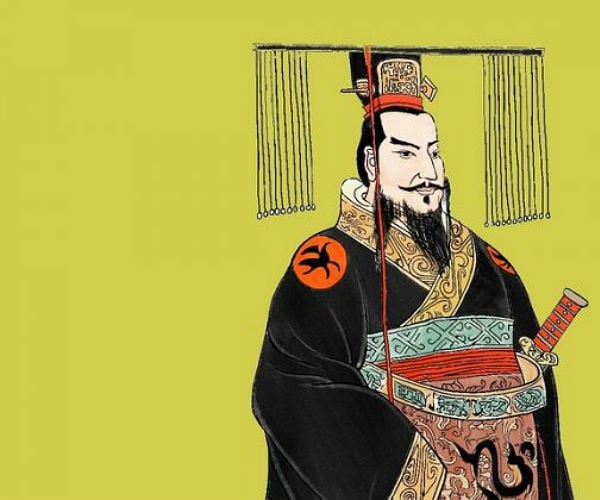 He is known as the Emperor of Two Miracles: the Great Wall and the Warriors. But he also stopped the civil war, unified the country, created a single currency and a common language, invented chrome-plating technology, built high-speed roads and dug canals to connect the Yellow River to the Lijiang and West Rivers, linking the main cities via a 437km waterway network.
He was 13 years of age when he became emperor and started planning his biggest initiative, his own mausoleum, the biggest in the world, out scaling even the pyramids. But his life was to end in tragedy 37 years later at only 50 years of age while his mausoleum was still under construction.
His principle was based on what seems to be an obsession during the China Dynasties, longevity in this life and a fulfilling afterlife. His coffin was to be floated on a river of mercury 100 metres below the surface, which he believed would protect his body, on top of which he instructed to have a 100 metre high hill built surrounded by the natural course of the Yellow River.
He is known as the Emperor of Two Miracles: the Great Wall and the Warriors. But he also stopped the civil war, unified the country, created a single currency and a common language, invented chrome-plating technology, built high-speed roads and dug canals to connect the Yellow River to the Lijiang and West Rivers, linking the main cities via a 437km waterway network.
He was 13 years of age when he became emperor and started planning his biggest initiative, his own mausoleum, the biggest in the world, out scaling even the pyramids. But his life was to end in tragedy 37 years later at only 50 years of age while his mausoleum was still under construction.
His principle was based on what seems to be an obsession during the China Dynasties, longevity in this life and a fulfilling afterlife. His coffin was to be floated on a river of mercury 100 metres below the surface, which he believed would protect his body, on top of which he instructed to have a 100 metre high hill built surrounded by the natural course of the Yellow River.
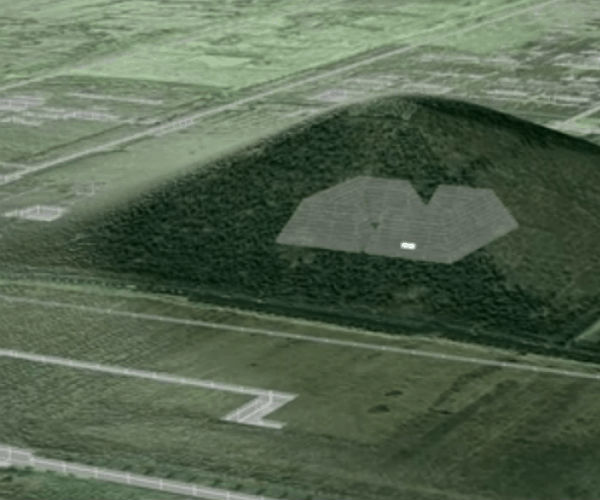 Below ground he set traps using crossbows and spears – real Indiana Jones stuff – to protect against tomb raiders and looters. He then commissioned all the craftsmen in the newly unified country to construct life-size warriors to defend him. All eight thousand of them along with horses, animals, eunuchs and acrobats for entertainment in the afterlife. This guy had more than a healthy preoccupation about his own death.
Below ground he set traps using crossbows and spears – real Indiana Jones stuff – to protect against tomb raiders and looters. He then commissioned all the craftsmen in the newly unified country to construct life-size warriors to defend him. All eight thousand of them along with horses, animals, eunuchs and acrobats for entertainment in the afterlife. This guy had more than a healthy preoccupation about his own death.
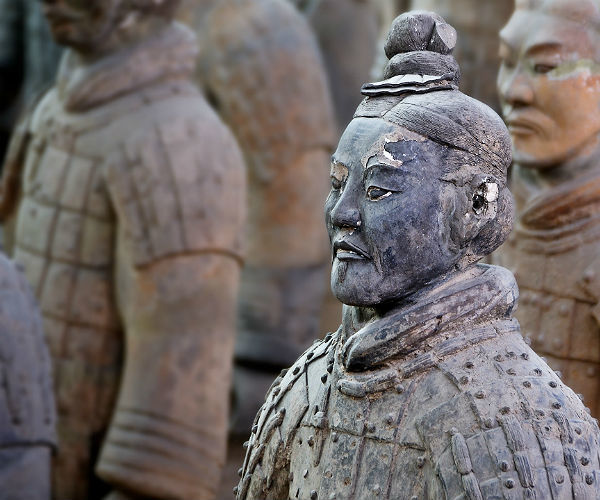 Our terrific guide Pan dodged us through the queues and led us to the first of only three pits that have been excavated to date. A construction larger than an aircraft hangar covered the pit containing hundreds of warriors row after row all facing the same direction, their backs to their ruler’s tomb ready to defend his honour. The pit was divided into rooms separated by thick walls and once covered with beamed roofs.
Our terrific guide Pan dodged us through the queues and led us to the first of only three pits that have been excavated to date. A construction larger than an aircraft hangar covered the pit containing hundreds of warriors row after row all facing the same direction, their backs to their ruler’s tomb ready to defend his honour. The pit was divided into rooms separated by thick walls and once covered with beamed roofs.
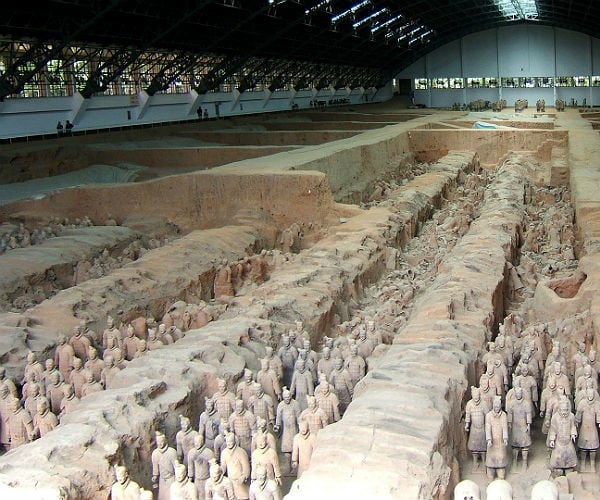 Pan explained that Qin Shi Huang had directed clay to be used from a nearby mountain, moulds were made for the life-sized bodies then arms and heads were made separately and attached. After firing they would last forever, protecting him for eternity. Every warrior they have found so far has a different face and the name of the craftsman engraved on the back of its neck. Legend has it that if the emperor didn’t like the design the craftsman would be identified and executed.
‘So, that’s why they’re called “The Terracotta Army”, Pan?’ I asked.
‘No, not really,’ she said.
Apparently, when excavation began, they found brightly painted warriors, but as soon as they were exposed to the air the colours began to fade, and within 30 minutes they were the colour of terracotta, and the description stuck.
Pan explained that Qin Shi Huang had directed clay to be used from a nearby mountain, moulds were made for the life-sized bodies then arms and heads were made separately and attached. After firing they would last forever, protecting him for eternity. Every warrior they have found so far has a different face and the name of the craftsman engraved on the back of its neck. Legend has it that if the emperor didn’t like the design the craftsman would be identified and executed.
‘So, that’s why they’re called “The Terracotta Army”, Pan?’ I asked.
‘No, not really,’ she said.
Apparently, when excavation began, they found brightly painted warriors, but as soon as they were exposed to the air the colours began to fade, and within 30 minutes they were the colour of terracotta, and the description stuck.
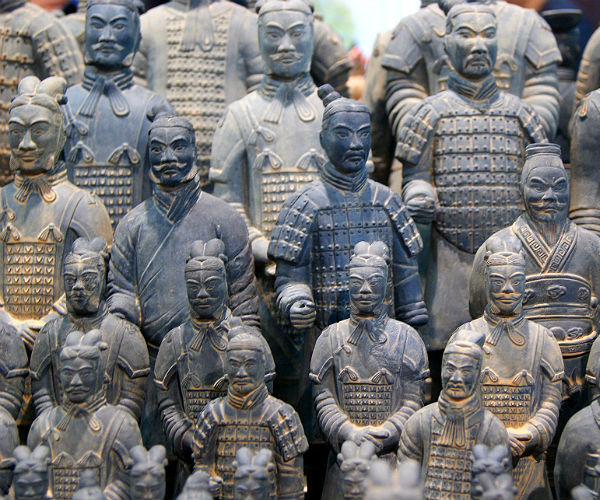 We visited all three of these remarkable pits containing around two thousand warriors standing to attention in line and in expectation of battle, bizarrely resembling a scene from the science fiction film ‘I, Robot’. The detail and intricacy of carving was extraordinary, even after 2000 years the fingernails, facial wrinkles and strands of hair are easily identifiable, particularly on those of a senior military rank where more attention was paid to the carving.
We visited all three of these remarkable pits containing around two thousand warriors standing to attention in line and in expectation of battle, bizarrely resembling a scene from the science fiction film ‘I, Robot’. The detail and intricacy of carving was extraordinary, even after 2000 years the fingernails, facial wrinkles and strands of hair are easily identifiable, particularly on those of a senior military rank where more attention was paid to the carving.
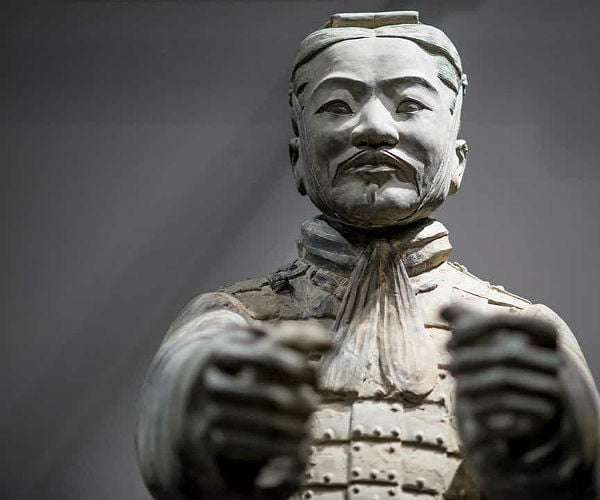 ‘There are another six hundred pits yet to be discovered,’ said Pan.
This piece of information seemed impossible, but another six thousand warriors have been detected by underground scanner and will not be excavated until the technology is available to protect their quickly vanishing colour. In other pits there are untold treasures still defended by the emperor’s traps and his river of mercury.
It was an incredible experience and another of our adventure’s highlights China had presented us, both from Emperor Qin Shi Huang . So what of his dreadful demise? It seems his obsession with a long life was the cause of his short existence.
‘There are another six hundred pits yet to be discovered,’ said Pan.
This piece of information seemed impossible, but another six thousand warriors have been detected by underground scanner and will not be excavated until the technology is available to protect their quickly vanishing colour. In other pits there are untold treasures still defended by the emperor’s traps and his river of mercury.
It was an incredible experience and another of our adventure’s highlights China had presented us, both from Emperor Qin Shi Huang . So what of his dreadful demise? It seems his obsession with a long life was the cause of his short existence.
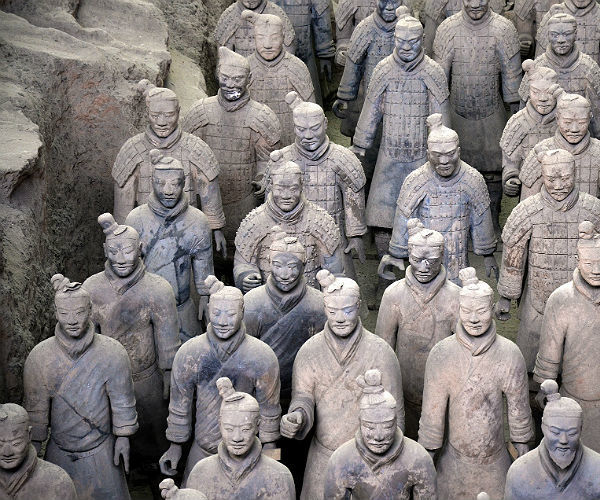 His scholars and advisers referred him to a written legend suggesting there was an elixir for long life that could only be discovered by monks.
‘Off you go then, boys,’ he may have said, ‘and don’t come back without it.’
Of course, it didn’t exist but the monks, in fear of losing their lives if they returned empty handed, found mercury.
‘This looks like it would make a good elixir for a long life,’ they may have said erroneously and returned to present the emperor with the solution to immortality.
The daily potion of perpetuity inevitably took its toll and while the monks survived, the emperor sadly went mad, executing swathes of the population. He eventually died of poisoning and brain damage and the peasants rebelled looting what they could from his Terracotta Army. A sad end for an emperor now held in the same esteem in China as Chairman Mao.
David Moore is Author of ‘Turning Left Around the World’. Published by Mirador and available from Amazon, it is an entertaining account of David and his wife’s travel adventures – often intriguing, frequently funny and occasionally tragic.
If you would like to be a guest blogger on A Luxury Travel Blog in order to raise your profile, please contact us.
His scholars and advisers referred him to a written legend suggesting there was an elixir for long life that could only be discovered by monks.
‘Off you go then, boys,’ he may have said, ‘and don’t come back without it.’
Of course, it didn’t exist but the monks, in fear of losing their lives if they returned empty handed, found mercury.
‘This looks like it would make a good elixir for a long life,’ they may have said erroneously and returned to present the emperor with the solution to immortality.
The daily potion of perpetuity inevitably took its toll and while the monks survived, the emperor sadly went mad, executing swathes of the population. He eventually died of poisoning and brain damage and the peasants rebelled looting what they could from his Terracotta Army. A sad end for an emperor now held in the same esteem in China as Chairman Mao.
David Moore is Author of ‘Turning Left Around the World’. Published by Mirador and available from Amazon, it is an entertaining account of David and his wife’s travel adventures – often intriguing, frequently funny and occasionally tragic.
If you would like to be a guest blogger on A Luxury Travel Blog in order to raise your profile, please contact us.Did you enjoy this article?
Receive similar content direct to your inbox.


I always like a story with a good moral. Quite a few lessons there for us today with our unthinking obsessions for extending our lives and pointless search for immortality. Highly ironic that the Emperor died naively taking an elixir – mercury – that he thought would prolong his life. How many of the health fads that we follow today, without being thoroughly researched and proven, are likely to shorten rather than prolong our lives?
Great credit to the Chinese authorities for not falling for the temptation to dig out the remaining warriors. It shows commendable restraint that they are waiting for the technology to catch up so that future generations can enjoy the full colours of what will be much more exciting than a Terracotta Army.
Great story-telling. There’s always a story to be told when you travel. Love the little bit of a conversation with the guide. Nice piece which brightened up my Sunday.
Mr Yang certainly got quite the shock! The Qing Dynasty is fascinating, especially learning what they believed would be helpful in the afterlife. Floating in mercury and building a giant hill is certainly an interesting one. He wasn’t taking any chances with all those booby traps either! It’s amazing how much work went into the construction of what’s been excavated so far, because eight thousand of these little guys is no mean feat. I wonder how long it’ll be until they can attempt digging up those remaining six thousand?
What a great story. This might sound a little funny, but I saw this on a movie the other night — the Mummy 3, I think. Hah. And when they got into the tomb, there were booby traps, etc. After reading this, I realize how much they borrowed from the real-life tombs of Emperor Qin Shi Huang. I would really love to see this one day. The detail on the terracotta figures is truly incredible.